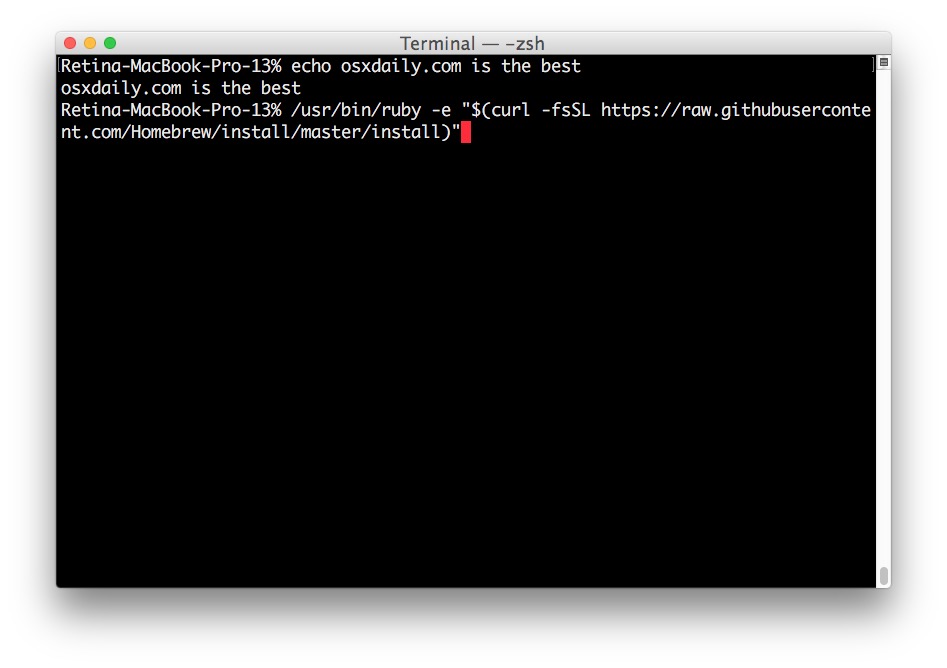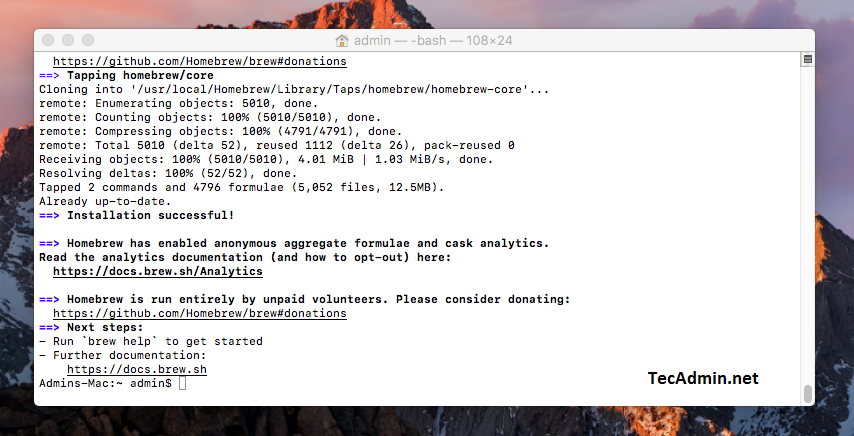Download Homebrew Mac
The current Gradle release is 7.2. You can download binaries and view docs for all Gradle versions from the releases page.
Download: Credits: F.A.Q. These files are not for sale. The Homebrew Channel is now installed using the all-in-one HackMii Installer. Please follow the.
Prerequisites
Gradle runs on all major operating systems and requires only a Java JDK version 8 or higher to be installed. To check, run java -version:
Additional resources
- On-demand and live online training is available for free to Gradle users.
- Self-paced tutorials are a good place to try Gradle with a variety of languages in addition to the docs.
- Gradle has a visual build inspection tool: Build Scan™.
- Finally, the Gradle Newsletter is a great way to keep
UP-TO-DATE, with issues crafted monthly.
Step 4 — Installing, Upgrading, and Removing Packages. Now that Homebrew is installed, use it to download a package. The tree command lets you see a graphical directory tree and is available via Homebrew. Install tree with the brew install command: brew install tree. Feb 10, 2021 How to install homebrew (brew) on M1 Mac 📅 Last Updated: 10 Feb 2021 17:41 GMT 👤 User: @c2cDev Homebrew now provides native support for MacBooks with M1 Silicon, installing brew on macOS Big Sur is simple, just open terminal and run the below command. Download for macOS. There are several options for installing Git on macOS. Note that any non-source distributions are provided by third parties, and may not be up to date with the latest source release. Install homebrew if you don't already have it, then: $ brew install git. Apple ships a binary package of Git with Xcode.
Installing with a package manager
SDKMAN! is a tool for managing parallel versions of multiple Software Development Kits on most Unix-based systems.
Homebrew is “the missing package manager for macOS”.
Other package managers are available, but the version of Gradle distributed by them is not controlled by Gradle, Inc. Linux package managers may distribute a modified version of Gradle that is incompatible or incomplete when compared to the official version (available from SDKMAN! or below).
› Additional helpful information
Installing manually
Step 1. Download the latest Gradle distribution
The current Gradle release is version 7.2, released on 17 Aug 2021. The distribution zip file comes in two flavors:
- Complete, with docs and sources
If in doubt, choose the binary-only version and browse docs and sources online.
Need to work with an older version? See the releases page.
Step 2. Unpack the distribution
Linux & MacOS users
Unzip the distribution zip file in the directory of your choosing, e.g.:
Microsoft Windows users
Create a new directory C:Gradle with File Explorer.
Open a second File Explorer window and go to the directory where the Gradle distribution was downloaded. Double-click the ZIP archive to expose the content. Drag the content folder gradle-7.2 to your newly created C:Gradle folder.

Alternatively you can unpack the Gradle distribution ZIP into C:Gradle using an archiver tool of your choice.
Step 3. Configure your system environment
Linux & MacOS users
Configure your PATH environment variable to include the bin directory of the unzipped distribution, e.g.:
How To Download Homebrew Mac
Microsoft Windows users
In File Explorer right-click on the This PC (or Computer) icon, then click Properties -> Advanced System Settings -> Environmental Variables.
Under System Variables select Path, then click Edit. Add an entry for C:Gradlegradle-7.2bin. Click OK to save.
Step 4. Verify your installation
Open a console (or a Windows command prompt) and run gradle -v to run gradle and display the version, e.g.:
› Additional helpful information
Upgrade with the Gradle Wrapper
If your existing Gradle-based build uses the Gradle Wrapper, you can easily upgrade by running the wrapper task, specifying the desired Gradle version:
Note that it is not necessary for Gradle to be installed to use the Gradle wrapper. The next invocation of gradlew or gradlew.bat will download and cache the specified version of Gradle.
› Additional helpful information
Older Releases
You can find all releases and their checksums on the releases page.
Command-Line Completion
Command-line completion scripts are available for bash and zsh. This provides completion for Gradle tasks and command-line options.
Homebrew is the most popular package management tool for macOS systems. Using the brew command line utility you can easily add new packages on your mac, but first, you have to install it. This tutorial will help you to install Homebrew on your system using simple commands.
Install Homebrew on macOS
Launch the terminal (/Applications/Utilities/Terminal) application on your system and then run below command on it
The installation process will prompt for the password. Just enter your password where required to complete the Homebrew installation. The process will take some time.
Once the installation completed, execute the below command to check version.
You may also run the below command to ensure everything is configured correctly.
The above command will show the instructions for correcting any issues.
Upgrade Homebrew
To upgrade Homebrew, execute the command below in terminal prompt.
Uninstall Homebrew?
Homebrew Osx

To uninstall Homebrew, execute the command below in a terminal prompt.
You can also download the uninstall script and run as below to view more uninstall options.